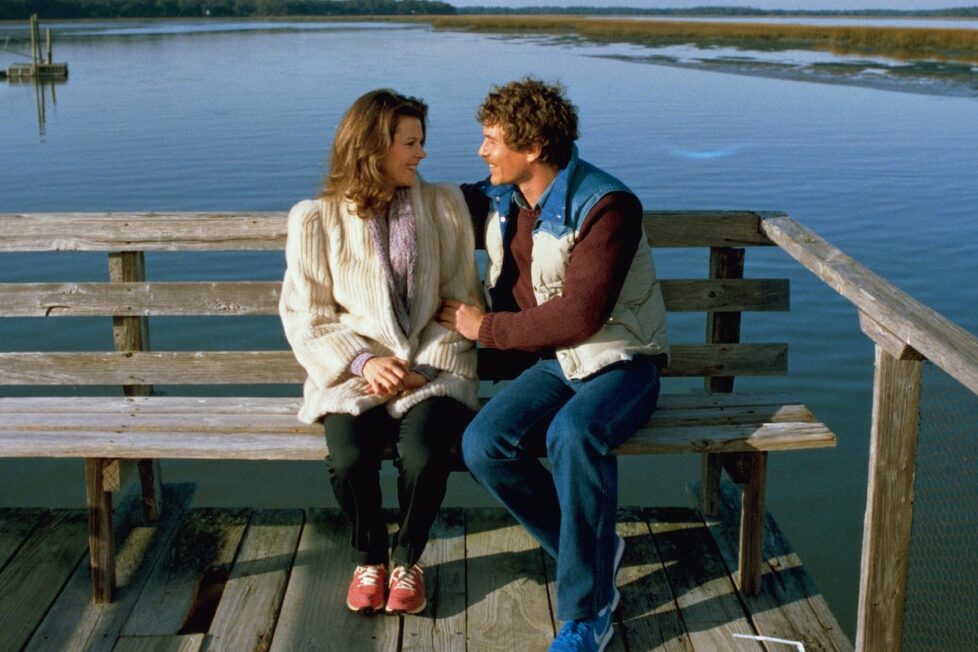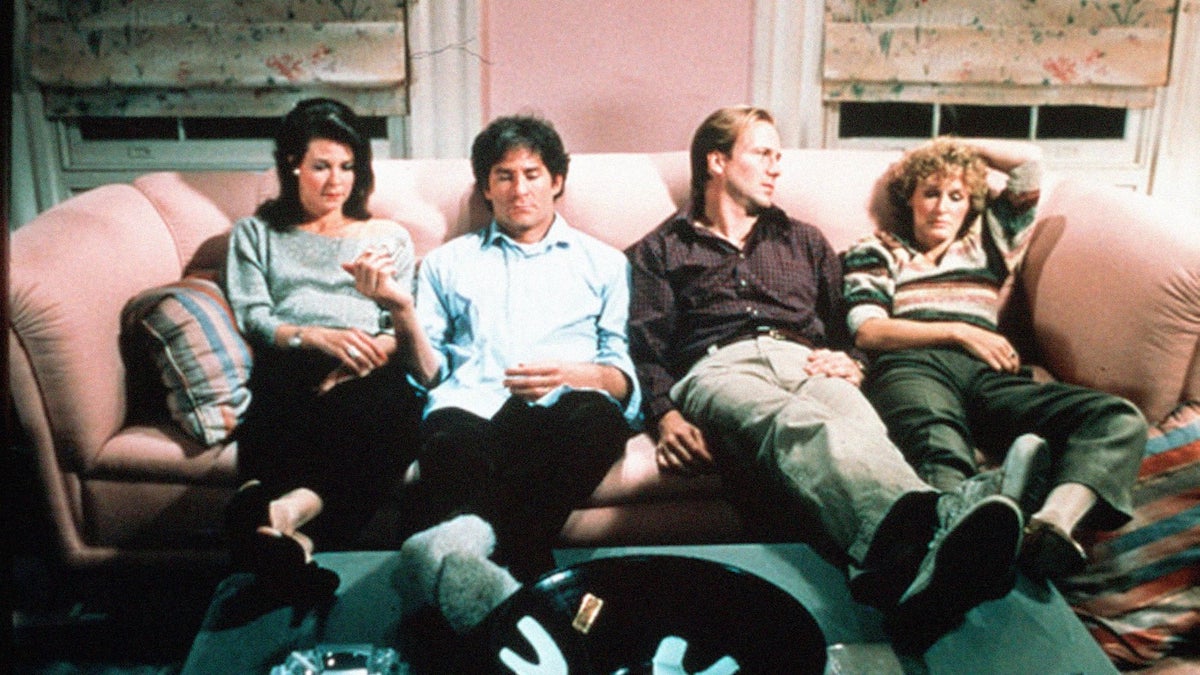THE BIG CHILL (1983)
A group of former college friends gather for a weekend reunion after the funeral of another of their college friends.

A group of former college friends gather for a weekend reunion after the funeral of another of their college friends.


We open with a middle-aged father, Harold Cooper (Kevin Kline), bathing his young son. He hears his wife, Dr Sarah Cooper (Glenn Close), devastated on the phone. Looking up, he sees her ashen face. A montage begins with the strains of Marvin Gaye’s “I Heard It Through the Grapevine”. Karen Bowens (JoBeth Williams) and Meg Jones (Mary Kay Place) stare despondently into space. Michael Gold (Jeff Goldblum) gets stressed over something small and has to be comforted by his partner. Sam Weber (Tom Berenger) has drunk several vodka miniatures on a flight. Nick Carlton (William Hurt) is popping pills as he drives his battered Porche down the highway. Interspersed, we see tight close-ups of a man’s tie getting done up by a woman’s hand with sexy red nails. We see his shoes being laced by this woman’s hand. Then, as the montage ends, we see his suit collar pulled over his wrist, covering the neatly stitched scars of his suicide. It’s an example of the gentle filmmaking wit that The Big Chill deploys in every scene.
Written by Lawrence Kasdan and Barbara Benedek, and directed by Kasdan, The Big Chill spends a long weekend with an old friendship group as they reconnect and try to come to terms with the suicide of one of their number. There’s the TV star, the “happily” married-with-kids couple, the less happily married one, the preternaturally single-and-ready-to-mingle journalist asshole, the single-but-desperate-for-a-kid one, the fuck-up psychologist bad boy nihilist, and the dead man’s much-younger girlfriend with seemingly nothing between her ears. They get together, chat, air old grievances, take drugs, drink a lot, cook, dance, go jogging, play football… they wonder about where their lives went wrong or right…. they wonder about the road not taken. And it’s no spoiler to say that few of their issues are resolved.

Kasdan is most famous for co-writing Star Wars: The Empire Strikes Back (1980) and Raiders of the Lost Ark (1981), and he brings the same wit and likeability that he brought to Han and Leia and Indy and Marion to all the characters here. These are all intelligent, funny, and philosophical people. Although they appear to occupy a deliberate spectrum of work/life situations, each character’s complex enough to convince as a real person. If there’s a criticism, it’s that they’re a hegemonic group of white, straight, middle-class types. If it was made today they’d be far more diverse, although Hollywood is still obsessed with telling us stories about people who earn more than us.
They are one big friendship group, and yet they’re naturally split into their little pairings and smaller groups. There are the men, the women, the married ones, the single ones, the professionals, the parents, the ones who always wanted to sleep together, the one who always wanted to sleep with anyone and everyone, the drinkers, the drug takers, the straight-laced ones… the insomniacs, the early-risers, the last-to-the-breakfast-table ones. They convince as one of those loose groups, not bound together as one unit with a shared experience, but by the multiple connections between them.
But more than the individuals, it’s the interactions the film really gets right. Joking at a friend’s funeral, making light of why he might have taken his own life. Teasing each other about their successes, whether it’s taking the piss out of the TV show someone stars in or mocking the deferential way someone is treated by their employees. Goldblum’s journalist is nakedly interested in having sex with his dead friend’s girlfriend, his friends mock him. Hurt’s failed psychiatrist is self-destructing and his friends try to save him with barbs. And between the others runs a web of affairs and sexual encounters both past and planned for the future, all of which are interrogated. It’s laugh-out-loud funny, but it also prods at our natural instincts for regret. The successful ones wonder if they’ve sold out, and the failures wonder if they made some crucial mistake. Perhaps by the end, just one or two of them are willing to be content.

To carry the audience along on what is a zero-stakes, zero-action tale that frequently returns to themes of suicide, the soundtrack is loaded with absolute bangers. Every ten minutes the needle gets dropped on a total chooon! Seriously, try to resist finding The Big Chill Spotify playlist afterwards and dancing around the kitchen whilst tin-foiling leftover turkey like Close and Kline. Shot by John Bailey, the film is a masterclass in how to film groups of people talking in rooms. Kasdan never imposes himself on the drama, camera movement is subtle and effective. When the camera pushes in for a close-up, you know exactly what the character is thinking.
It’s moments like that that tell you everything is working well, the storytelling craft on display here is staggering if you think about it, but you won’t think about it because it stays out of view. It also never gets boring, which is a testament to the screenplay and direction, but mostly to editor Carol Littleton. Conversations are intercut just enough to keep the pace up, to allow for juxtaposition, but then when everyone is together the scenes are allowed to play out for as long as they need. The decision to shoot in a real house, or should I say mansion, pays dividends, and without that kind of real-world-rooting influence on every scene, it’s possible the entire drama would collapse.
If the film has a point to make, it’s about the positive power of a friendship group. When they’re out in the cold world as individuals these friends can feel lost and lonely, but when they’re together they know who they’re supposed to be. When they’re alone they can fool themselves, but when they meet up their friends will always call them on their bullshit. Is there a lesson to be learnt? Probably not. Is there a purpose to life? Definitely not. Should you just stop worrying and spend more time with the people who know you best? Absolutely. As Mary Schmich once said, “work hard to bridge the gaps in geography and lifestyle, for as the older you get the more you need the people you knew when you were young.” Subtle, affecting, serious, funny, sobering, heartwarming, and mesmerizing, The Big Chill is that all too rare thing: a perfect movie.
USA | 1983 | 105 MINUTES | 1.85:1 | COLOUR | ENGLISH


director: Lawrence Kasdan.
writers: Lawrence Kasdan & Barbara Benedek.
starring: Tom Berenger, Glenn Close, Jeff Goldblum, William Hurt, Kevin Kline, Mary Kay Place, Meg Tilly, JoBeth Williams & Don Galloway.
